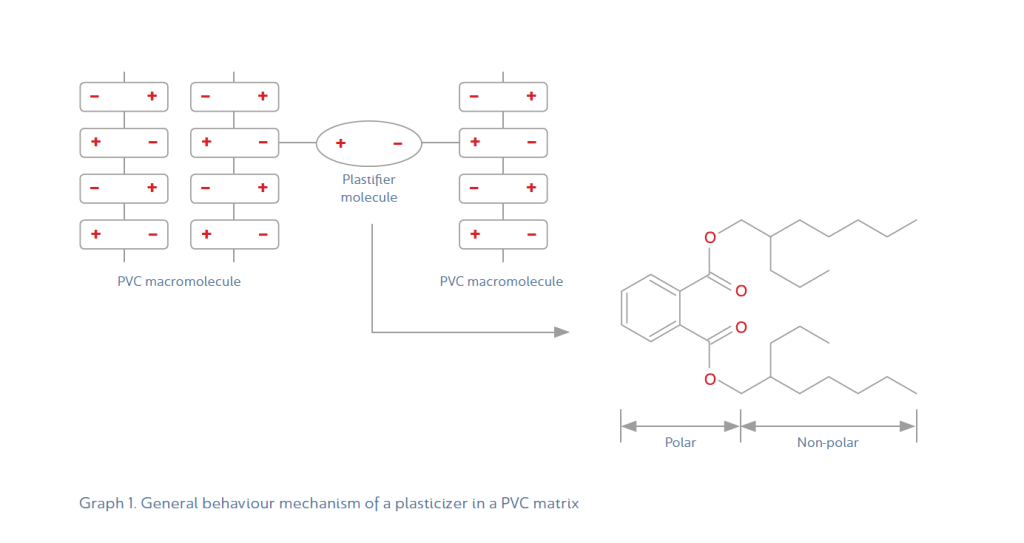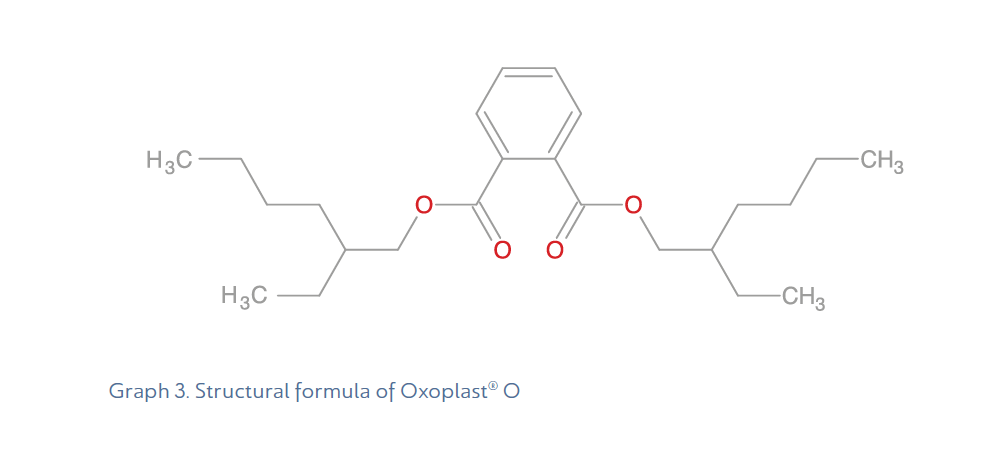PVC plasticization
PVC plasticisation is a process in which plasticizer molecules penetrate polymer macromlecules chains or agglomerates, in which causes weaker intermolecular forces and larger distances between chains (chain segments) in the polymer (Graph 1). That lowers the temperature of glass transition and flow, which leads to a decrease in the temperature of gelation and processing, giving the product new physical qualities (softening, flexibility).
The polarity of the plasticizer itself, namely a higher concentration of a negative charge in one place of its molecule and a lower in another, which makes the plasticizer a dipole, plays an important part in the very process of plasticisation. Polar molecules have several properties. They are able to solvate, i.e. to surround other polar molecules. A very general assumption may be made that compounds with areas in their structures that are ‚marked’ with a charge (polar substances) react more easily with other polar substances as their partial charges create an electric field which draws other reversely charged molecules and keeps them in the vicinity; consequently, it facilitates the chemical reaction.
Particles of Oxoviflex® and Oxoplast® O differ in their structure (Graph 2, Graph 3), with large discrepancies in polarity. Oxoviflex® is less polar; therefore, it is necessary to employ a more detailed approach to PVC processing than in the case of Oxoplast® O.
PVC processing using Oxoviflex® – process recommendations
In order to obtain the desired stability for the product created with the use of Oxoviflex®, special attention should be paid to several important aspects that may affect the course of PVC processing. Weaker polarity in comparison to Oxoplast® O equalsmore time to complete the plasticisation process and greater sensitivity to fillers. However, an important role may also be played by the manner of preparing the paste for coating (feeding order) and the necessity of exploiting full machinery park that is recommended for such processing. A set of recommendations for particular stages of PVC processing are presented below.
- Dose – There is no explicit indication to increase the amount of Oxoviflex® in paste mixtures comparing to Oxoplast® O dose. The only recommendation is not to overdose Oxoviflex® used in the PVC mixture in relation to its absorption capacity. An overdose can lead to free (not bonded with the PVC) elements of the plasticizer in the finished product.
- Filler – The acceptable amount of fillers, whether in the form of chalk or other, should not significantly exceed 10 phr, with the PVC constituting 100 phr. Recommended amounts worked very well in the PVC/Oxoplast® O combination;however, in the event of a significant overdose (in spite of a better polarity of Oxoplast® O), the finished product was subsequently prone to damage. A significant amount is understood as 20 phr of the filler and more.
- Feeding order – The necessity to change the order of adding dry ingredients into the prepared coating-related mixture may prove to be important. It becomes so especially if not all recommended machinery (three-roll mills) is used to prepare PVC pastes, but they are rather stabilised after being mixed beforehand. It is recommended to fill the mixer with PVC in the amount specified in the guidelines right after Oxoviflex® is delivered into it. The mixture should then be stirred and left for a minimum of six hours. After that, all other components including fillers can be added. Afterwards, the product should be mixed and stabilised for a total time of 48 h. The suggested treatment should minimise subsequent risk of plasticizer migration in cases where full machinery recommended for paste preparation was not used.
- Paste rolling – Plasticizer molecules penetrate polymer chains; however, the ingress into the grains and their solvation are usually very slow. To speed up this process, an intermediate step in the production process is essential. It is located between the making of the paste and its final placement on carrier paper in the coating process. This stage entails rolling the PVC paste on three-roll mill. During this process, the paste is heated (which speeds up the process of plasticisation) and all components of the paste become evenly distributed. This allows for a faster onset of the desired chemical processes. It is crucial if a less polarised plasticizer is used.In processes where the preparation of pastes with the Oxoviflex® plasticizer involves a three-roll mill, there is no need to change the filling order comparing to Oxoplast® O based formulations. In such a case, the recommended time of stabilizing is shorter and lasts for 24 h.
Plasticizer migration – how does it happen, how to prevent it?!
Summing up: an important difference between Oxoviflex® and Oxoplast® O, having a huge impact on the course of plasticization, is weaker polarity of the first product. Thus, more time is needed to complete the plasticising process and greater sensitivity to fillers is noted.
Filling order, longer stabilisation, thus steps that may mitigate the effects of the difference in terms of time have been provided earlier. At the same time, it has been observed that for processes employing rolling machines, there was no need to change the dosage order and time of stabilisation compared to an analogous Oxoplast® O based formulation. Therefore, the activity of the filler itself within the PVC paste deserves a closer look.
All PVC paste fillers are to influence physical properties of a product (e.g. increase its hardness and/or resistance to abrasion) and noticeably lower production costs. Fillers are not playing an active part in the process of plasticising; in addition, their presence hinders plasticizer penetration of a polymer. Therefore, exceeding the recommended share (10 units of measure) significantly slows down and hinders PVC plasticising process. Thanks to its lower polarity, compared to Oxoplast® O, Oxoviflex® needs more time and, bearing in mind the fact that excessive amounts of the filler make it more difficult to penetrate PVC, the obvious conclusion is that plasticising under unfavourable conditions may not be complete. For this reason, the disintegration of the final product was noted for cases where the volume of the filler was significantly different from recommended.
It should be noted that an excessive amount of filler often means that the producer uses more plasticizer than it is needed for a given type of PVC in order to improve the viscosity of the paste. In such cases, even if it only applies to layers of glue, the finished product still includes a significant amount of free plasticizer, which could not be removed in the drying process (the inability to increase the time of exposure to temperature in the tunnel – presence of porophors).
While using the final product (e.g. furniture lined with a coated material), free plasticizer molecules are heated by sun rays or, as it often happens, the temperature of the human body. The non-bound plasticizer particles migrate towards the top layer (front) of the product; heat removes the plasticizer from its original location, which leads to rapid damage to the product in places of contact with the human body. The damage takes the form of hardened spots and cracks on the surface.
An important fact is that such a type of damage had been observed much earlier. It occurred regardless of the type of plasticizer used, but always depended on the amount of filler or completeness of the manufacturing process.
For these reasons, special attention is put to careful production process conduct in case of materials coated with the use of Oxoviflex®, with particular reference to the above recommendations for its key stages. Following them should eliminate a later risk of plasticizer migration.
Study of the degree of migration from PVCbased plastics unequivocally confirms that plasticizers with a molecular weight of less than 250 g/mol and boiling temperature below 350 °C should be avoided. Oxoviflex® fully meets these requirements. Its molecular weight is 390,6 g/mol, the boiling point is 375°C. Oxoviflex® satisfies all highest standards for plasticizers in the field of PVC processing.
Download expert article by Boris Fleites-Jończyk [PDF]
Author:
Boris Fleites-Jończyk joined the Grupa Azoty ZAK S.A. in 2016. He is a Coordinator – Technical Advisor of the OXO Segment. Boris Fleites-Jończyk, has Master’s degree in Mechanical Engineering. He is a specialist in the field of coated materials. He gathered his rich professional experience while working on managerial positions in manufacturing companies, which specialise in the production of coated materials for furniture, leatherworking and footwear industries.





